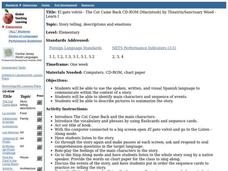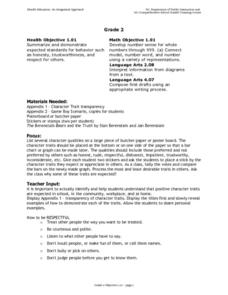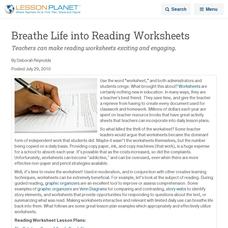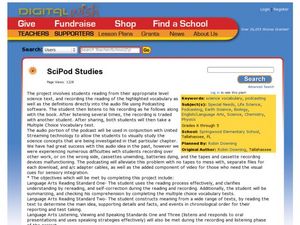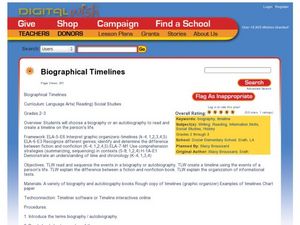Curated OER
Health Education: Body Fluids
Second graders take part in a germ experiment. In this personal health lesson plan, 2nd graders summarize appropriate measures to prevent contact with the body fluids of others.
Curated OER
Arthur's Tooth
Students practice their reading comprehension by reading a story in their class. In this story map lesson, students read the Marc Brown book Arthur's Tooth and discuss the story, characters and setting. Students create a story map based...
Curated OER
The Cat Came Back
Students are read the story "The Cat Came Back". Using Spanish, they communicate the context of the story with each other. They practice using new vocabulary, identifying main characters and putting the events into order. They use the...
Curated OER
Health Education: Earning Respect
Second graders explore how to earn respect. In this health lesson plan, 2nd graders summarize and demonstrate expected standards for behavior such as honesty, trustworthiness, and respect for others.
Curated OER
Rattling Review
Second graders watch a PowerPoint presentation, and distinguish between facts and myths about snakes. In this snakes lesson, 2nd graders discuss and review facts about snakes and summarize what they have inferred from the PowerPoint...
Curated OER
Hero Or Zero?
Students investigate science and technology by reading a children's book. In this reading comprehension instructional activity, students read the story Archibald Frisby and discuss the ways we use science and technology in everyday...
Curated OER
Get to the Point!
Students discover what summarization is and why it is important. They focus on the five steps used to summarize and observe as the steps are used to summarize the article "Ghost Tigers of the Rain Forest" out of National Geographic Kids...
Curated OER
Plug it All In
Second graders discover the meaning of silent reading and how it is an important part of reading fluently. They listen as the teacher models how to summarize a short paragraph using three steps and then read and re-read an article and...
Curated OER
Reading Predictions
Second graders read and predict content and purpose for table of contents, index, headings, captions, illustrations, and major words from their science or social studies textbooks. They use books' elements to summarize what they can find...
Curated OER
Breathe Life into Reading Worksheets
Teachers can make reading worksheets exciting and engaging.
Curated OER
“THE LORAX” by Dr. Seuss
Few children's books convey the message of conservation as well as Dr. Seuss' The Lorax. Read the story aloud, emphasizing the interconnectedness of plants and animals in an ecosystem and discussing different ways people can help the...
Curated OER
SciPod Studies
Have fun preparing a science podcast. After reviewing vocabulary, learners record audio files to create science vocabulary podcasts for particular units of study. A clever way to incorporate technology.
Curated OER
Editing
Take young authors through the writing process with a worksheet on editing. Given three sentences with unnecessary words, pupils cross out the extra words and write the rest of the sentence in the space provided. An excellent way to...
Achievement Strategies
CCSS Unit Design Template for PE
From baseball and tennis to capture the flag and four-square, here is a great document that will help you design your next unit on a sport-related activity.
Curated OER
The Battle to Save Bats
Students investigate the disease that is causing the global decline of bats. In this animal health lesson, students read an article which discusses white-nose syndrome, the number one killer of bats. Students discuss ways to keep bats...
Curated OER
Vocabulary: Multiple Meaning Words in Context
Learners use context clues to define words with multiple meanings. After extensive practice with their teacher, learners read through six sentences, they then identify a word with a multiple meaning, and determine its meaning based on...
Achievement Strategies
CCSS Unit Design Template for Art
Art classes, like any lab class, require extensive preplanning and set-up time. Use this planning template in the quiet before the storm to identify the equipment and materials that will be needed, the procedures and processes...
Pennsylvania Department of Education
Analyzing Literary Elements in Fiction
Students analyze the characters and events in fictional writing. In this literary elements lesson, students study the meaning of the words characterization and fiction. They listen to the story Pigsty by Mark Teague, or any other book...
Curated OER
Twisting Versions of Little Red Riding Hood
Students read orally two versions of Little Red Riding Hood (Classic and Cajun) They compare and contrast the two Little Red Riding Hood versions. Students create a concept map to demonstrate the comparisons/contrasts. They could also...
Curated OER
Why Mosquitoes Buzz in People's Ears
Second graders study folktales and their characteristics. After brainstorming what they know about Africa, 2nd graders read a book about mosquitoes. In groups, students develop a graphic organizer about the characteristics of the...
Curated OER
Nursery Rhymes
Students recall details of nursery rhyme read by teacher, identify main characters, and demonstrate knowledge of poem by creating concept map about story that includes title, clip art, and changes in font and color.
Curated OER
History Close to Home
Students examine primary sources as related to Nevada and the Civil War. In this United States history lesson, students gather and analyze various primary sources in small groups and interpret unknown vocabulary words by using context...
Curated OER
The Life of George Washington Carver
Second graders investigate historic Americans by researching George Washington Carver. In this famous American biography lesson, 2nd graders complete graphic organizers about George Washington Carver's life while researching the...
Curated OER
Biographical Time lines
Young scholars create a time line. In this biography lesson, students define biography and autobiography and then read short examples of each. Young scholars create a time line using a read aloud.




